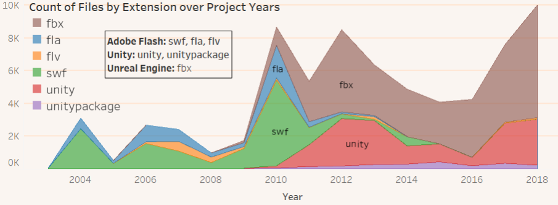During my time with the SHFT group I’ve been investigating the effects of the deprecation of Adobe Flash in 2020, and what implications it had on the preservation community. The project stemmed from my teammates work on the ETC Data Analysis project which analyzed 18TB of interactive art projects from 2000-2021 provided by Carnage Mellon University’s Entertainment Technology master program.

Upon my teammates analysis of the data, we found that at least 70 projects (16%) were made with Adobe Flash. This meant that a significant number of files were inaccessible to us for our research and analysis. This sparked my investigation into the online preservation efforts of Adobe Flash and what the active community is doing to try to preserve its access.
Thus far our research has unveiled critical insights into the complex discontinuation of Flash, as a widely prevalent proprietary software, and its implications for historical preservation. Our goal has become to illustrate the ongoing preservation challenges and hopefully provide potential guidance for future preservation of popular platforms.
We found that the process by no means is straight forward nor linear. Due to the popularity of the platform some preservation efforts even started in the early 2010s with efforts to build alternatives. Further complexity is added due to the proprietary nature of the software itself; this means that the assets of Flash production need to be entirely reverse-engineered or translated into modern formats. Furthermore, Flash is still offered to enterprises through an Adobe distribution partner, and Flash is still widely used in China to this day.
We hope that by distilling and breaking down the preservation process and it's challenges we can provide insights for future platform deprecation. As our lives are increasingly spent online, the rise and fall in popularity of online platforms are inevitable, making this field even more important to study. There has long been an oversight in industry and research regarding software preservation. I hope the community one day in the near future agrees on a uniform exit strategy for end-of-life software.